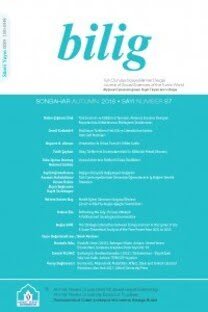Petrol Zengini Türk Ülkelerinde Volatilite, Çeşitlendirme ve Petrol Krizi
Ekonomik çeşitlendirme, petrole bağımlılık, subsidize edilen ekonomiler, Kazakistan, Azerbaycan, Türkmenistan
Volatility, Diversification and Oil Shock in Resource-Rich Turkic Countries: Avenues for Recovery
Economic diversification, oil dependence, subsidized economies, Kazakhstan, Azerbaijan, Turkmenistan,
___
Abdygaliyeva G. et al. (2007). “Economic Diversification in The Republic of Kazakhstan Through Small and Medium Enterprise Development: Introducing New Models of Funding for SME’s”. Center for Marketing and Analytical Research Report.Aleksandrova S. (2016). “Impact of Oil Prices on Oil Exporting Countries in the Caucasus and Central Asia”. Economic Alternatives 4.
Aslanli N. et al. (2013). “Assessment of Economic and Export Diversification: Azerbaijan”. Revenue Watch Institute Report.
Atkinson G. and K. Hamilton (2003). “Savings, Growth and the Resource Curse Hypothesis”. World Development 31 (11): 1793–1807.
Auty R. M. (1998). “Resource Abundance and Economic Development: Improving Performance for Resource-Rich Countries”. UNU-WIDER Research in Action 44.
Dabrowski M. (2016). “Currency crises in post-Soviet economies— a never ending story?”. Russian Journal of Economics 2: 302-326.
Esanov A. (2012a). “Economic Diversification: Dynamics, Determinants and Policy Implications”. Revenue Watch Institute Report.
Esanov A. (2012b). “Economic Diversification: The Case for Kazakhstan”. Revenue Watch Institute Report.
Felipe, J. (Ed.) (2015). Development and modern industrial policy in practice: Issues and country experiences. Edward Elgar Publishing.
Gelb (2010). “Economic Diversification in Resource Rich Countries”. Economic Drawn from the lecture on Natural resources, finance, and development: Confronting Old and new Challenges. Conference.
Gylfason, T, T. H. Tryggvi and Z. Gylfi (1999). “A Mixed Blessing, Natural Resources, and Economic Growth”. Macroeconomic Dynamics 3: 204–25.
Hasanov F. (2014). “Dutch disease and the Azerbaijan Economy”. Communist and Postcommunist Studies 46: 463-480.
Hasanov F. and F. Huseynov (2013). “Bank credits and non-oil economic growth: Evidence from Azerbaijan”. International Review of Economics and Finance 27: 597-610.
Hesse H. (2008). Export Diversification and Economic Growth. Commission on Growth and Development. Working Paper N. 21.
Hvidt M. (2013). “Economic Diversification in the GCC Countries”. Kuwait Programme on Development, Governance and Globalisation in the Gulf States. London School of Economics.
IMF (2016a). “Regional Economic Outlook: Middle East and Central Asia”. IMF Report.
IMF (2016b). “Economic Diversification in Oil-Exporting Arab Countries”. Annual Meeting of Arab Ministers of Finance.
Kaplinsky R. and M. Farooki (2011). “Promoting Industrial Diversification in Resource Intensive Countries”. United Nations Industrial Development Organization Report.
Leiderman D. and W. F. Maloney (2007). “Trade Structure and Growth”. Trade Structure and Growth, in Natural Resources: neither curse, nor destiny. Ed. D. Lederman and W. F. Maloney. World Bank. Stanford University Press.
Palan N. 2010. Measurement of Specialization – The Choice of Indices. FIW Working Paper No. 62.
Pomfret, R. (2012). “Resource management and transition in Central Asia, Azerbaijan and Mongolia”. Journal of Asian Economics 23 (2): 146-156.
Press Release: IMF Staff Concludes Visit to Turkmenistan. Accessed at: http://www.imf.org/external/np/sec/pr/2016/pr16193.htm [Online Source].
Ross M. L. (1999). “Political Economy of Resource Curse”. World Politics 51: 297-322.
Sabiroglu I. M. and S. Bashirli (2012). “Input-output analysis in an oil-rich country: The case of Azerbaijan”. Resources Policy 37: 73-80.
Sabonis-Helf T. (2007). “The Rise of the Post-Soviet Petro-States: Energy Exports and Domestic Governance in Turkmenistan and Kazakhstan”. In the tracks of Tamerlane: Central Asia’s Path in 21st Century. Ed. D. Burghart and T. Sabonis-Helf. Washington: University Press of the Pacific.
Torvik R. (2002). “”Natural resources, rent seeking and welfare”. Journal of Development Economics 67: 455–470.
- ISSN: 1301-0549
- Yayın Aralığı: Yılda 4 Sayı
- Başlangıç: 1996
- Yayıncı: Ahmet Yesevi Üniversitesi
TANAP Antlaşmalarının Uluslararası Hukuk ve Kamulaştırma Hukuku Açısından Değerlendirilmesi
Sanayi Sektöründe Petrol Talebinin Fiyat ve Gelir Esneklikleri: OECD Ülkeleri Örneği
Orhan ÇOBAN, Nazan ŞAHBAZ KILINÇ, Efe Can KILINÇ
Petrol Fiyatları, GSYİH ve Döviz Kuru Arasındaki Nedensellik: Azerbaycan ve Kazakistan Örneği
Mehmet DİKKAYA, Bayram Veli DOYAR
Geçiş Ülkelerinde Devlet Harcamaları ile Ekonomik Büyüme İlişkisi: Kırgızistan ve Tacikistan Örneği
Raziiakhan ABDİEVA, Damira BAİGONUSHOVA, Junus GANİEV
Petrol Zengini Türk Ülkelerinde Volatilite, Çeşitlendirme ve Petrol Krizi
Türkiye ve Rusya’nın İkili Ticaret İlişkilerinin Analizi
Nevzat ŞİMŞEK, Hayal Ayça ŞİMŞEK, Zhengizkhan ZHANALTAY
Markalama ve Millî Kimlik: “Türkiye: Gücünü ve Potansiyelini Keşfet” Kampanyası Analizi
Mehmet Akif DESTEK, İlyas OKUMUŞ, Abdulmecit YILDIRIM
Türk Dünyasında Yer Alan Ülkelerin Makro Performanslarının Karşılaştırılması
